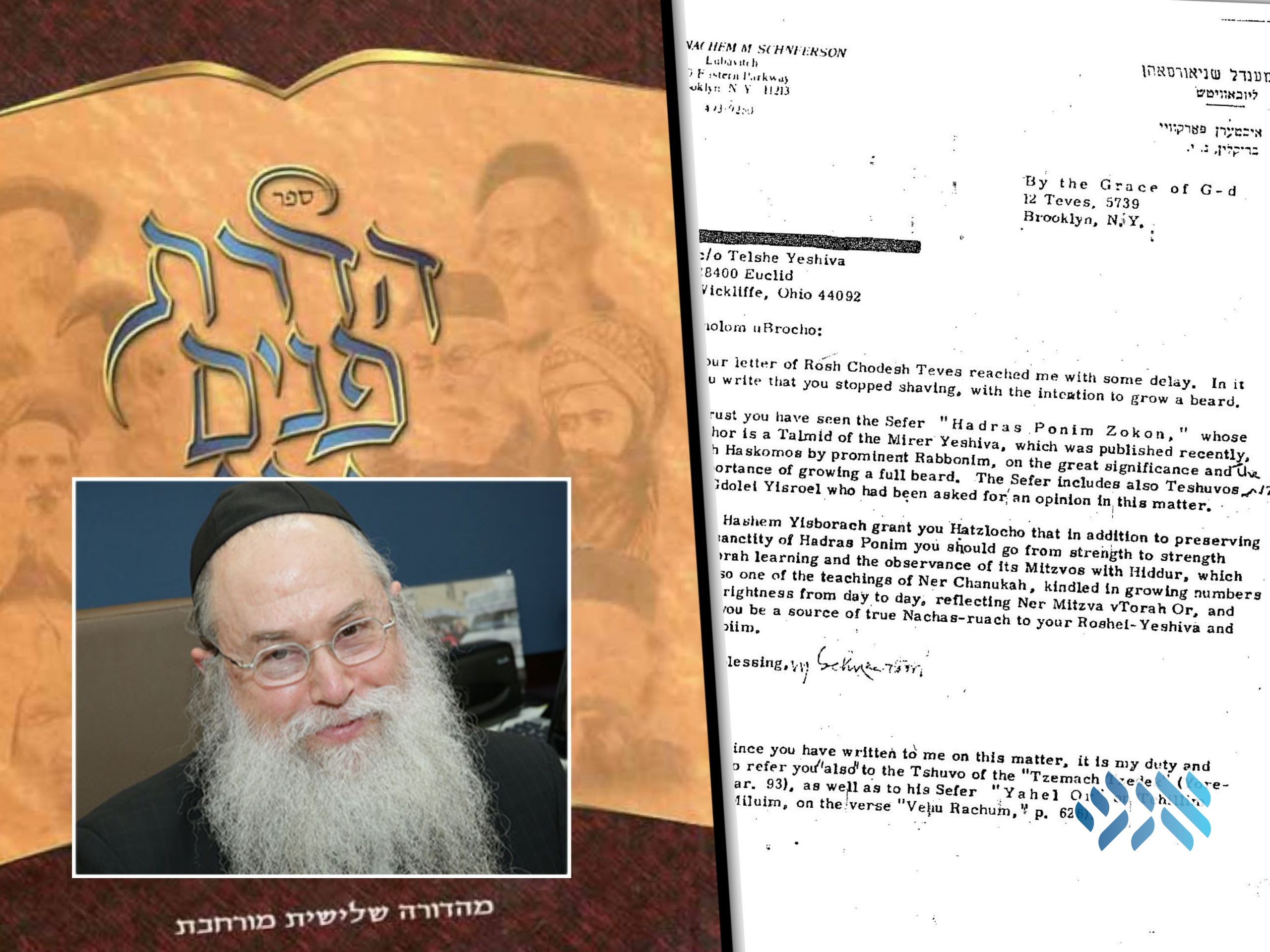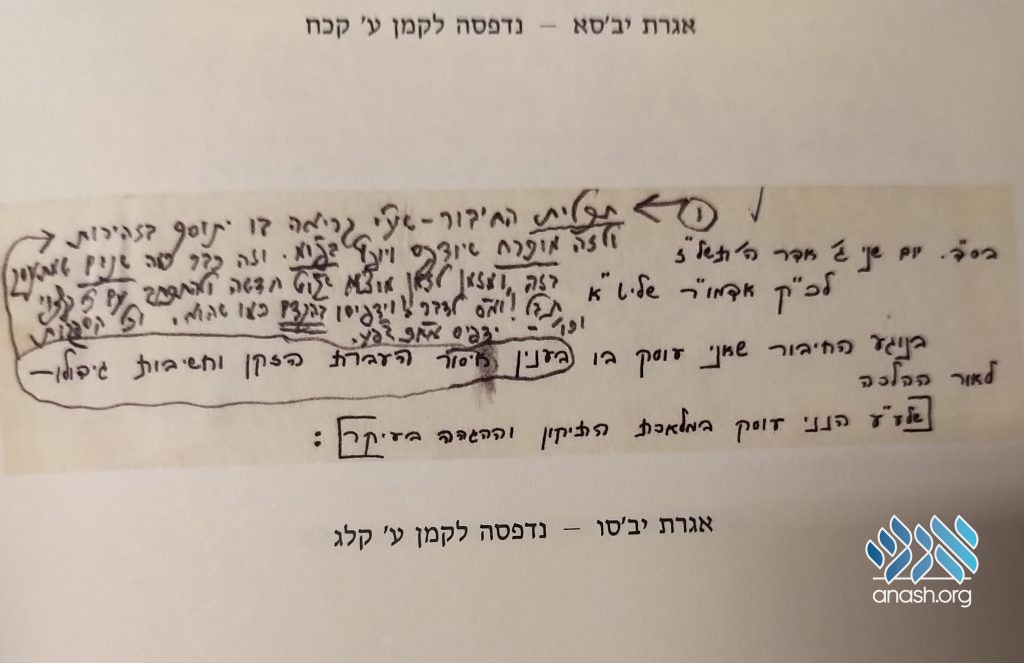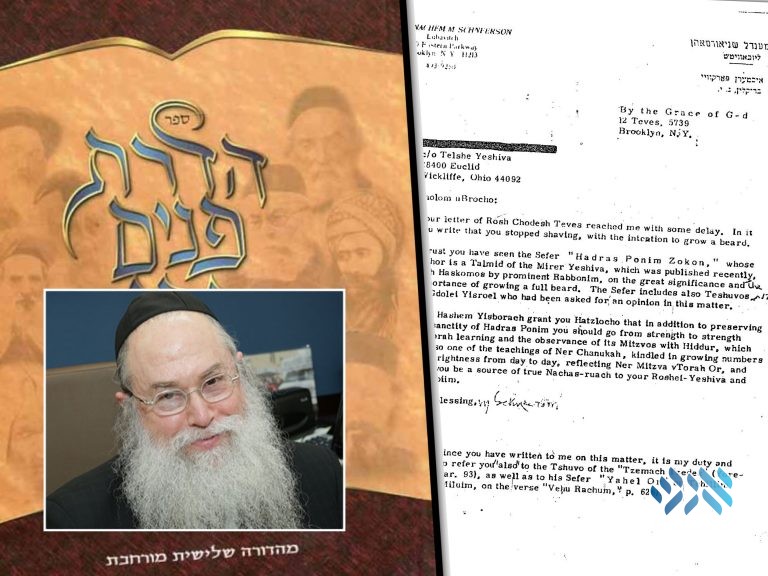כ״ד תמוז ה׳תש״פ | July 16, 2020
The Rebbe’s Secret Efforts to Get a Sefer Published
New research reveals the Rebbe’s extensive involvement in the publishing of Sefer “Hadras Ponim Zokon” by Rabbi Moshe Wiener, focused on the Torah’s instruction to grow a beard.

New research reveals the Rebbe’s extensive involvement in the publishing of Sefer “Hadras Ponim Zokon” by Rabbi Moshe Wiener, focused on the Torah’s instruction to grow a beard.
By Anash.org staff
In a recent issue of Hiskashrus, Rabbi Mordechai Menashe Laufer explores in great detail the Rebbe’s involvement in the Sefer Hadras Ponim Zokon.
Authored by Rabbi Moshe Wiener, Hadras Ponim Zokon is an encyclopedic work of over 1000 pages on cutting and growth of the beard in Halacha, and is the result of over 30 years of research.
Anash.org presents a translated by Rabbi Yehuda Altein with additions from archival material which do not appear in the original Hebrew article.
In 5738, a revolutionary sefer hit the market. Authored by a student of the Mirrer Yeshiva who became a Lubavitcher chossid, the comprehensive sefer presented the Torah approach to shaving and growing the beard. Its name? Hadras Ponim Zokon.
The sefer merited the haskamos of Rabbonim, Rebbes, and Roshei Yeshiva representing the wide diversity of Torah communities, who warmly applauded the work. However, its strongest proponent was the Rebbe, who guided and encouraged the author from the book’s inception until its printing, and beyond.
What is the story of this sefer and the Rebbe’s involvement? Read further and you will see.
The number of projects to strengthen Yiddishkeit the Rebbe was involved in will never be known to us. Often, the Jewish public was unaware of the Rebbe’s direct or indirect involvement. To the Rebbe, the main thing was that the goal be accomplished; if this necessitated keeping his influence under wraps, so be it.
One of these projects was the publishing of the sefer Hadras Ponim Zokon, a profound, erudite dissertation authored by Rabbi Moshe Wiener, devoted to portraying the Torah approach to shaving and growing the beard.
The Rebbe Advises a Student of the Telshe Yeshiva to Read Hadras Ponim Zokon
The Rebbe’s affinity to the sefer is demonstrated in an English letter to a bochur learning in Telz, dated 12 Teves, 5739:
Your letter of Rosh Chodesh Teves reached me with some delay. In it you write that you stopped shaving, with the intention to grow a beard.
I trust you have seen the Sefer “Hadras Ponim Zokon,” whose author is a Talmid of the Mirrer Yeshiva, which was published recently, with Haskomos by
prominent Rabbonim, on the significance and the must and importance of growing a full beard. The Sefer includes also Teshuvos Bruros [unequivocal halachic pronouncements] by Gdolei Yisroel who had been asked for an opinion in this matter.
May Hashem Yisborach grant you Hatzlocho that in addition to preserving the sanctity of Hadras Ponim you should go from strength to strength in Torah learning and the observance of its Mitzvos with Hiddur…
The first edition of the sefer, printed in Adar Rishon, 5738, made a powerful impression. It sold out within a few months, and was reprinted toward the end of that year, along with many important additions. In 5766, a third, expanded edition was published, featuring a total of no less than 1,024 pages (about 300 more pages than the first edition).
In the introduction to the first edition, the author relates that he wrote the sefer with “the blessings and support of the Gedolim of our generation, who encouraged me in my literary efforts and to whom I express my deepest gratitude.” When writing these words, there is no doubt that the author had in mind the Rebbe, who constantly spurred him on with encouragement and blessings and also guided him regarding the publication and later the publicizing and dissemination of the sefer.
“Publish the Book as Is as Soon as Possible!”
In a letter to the Rebbe dated 3 Adar, 5737, the author wrote that he had asked various Rabbonim to clarify some halachic difficulties relating to the contents of the sefer. As an example, he referenced the view of Rabbeinu Yonah, cited in a teshuvah of the Tzemach Tzedek (Yoreh Deiah, vol. 1, 93:9), in which he lacked clarity.
The Rebbe responded with a sharp maaneh (printed in Igros Kodesh, vol. 32, p. 133):
The goal of your book is that through reading it, people will be more scrupulous with the prohibition of removing the beard and will realize how critically important it is to grow it. To this end, it is imperative that it actually be published and distributed. You are working on it for a number of years now, and from time to time you discover a new academic perplexity, and you write letters to Rabbonim across the world! There is no end to this! Publish the book as is as soon as possible.
As far as all your scholarly dilemmas are concerned, publish them as a separate booklet at a later time.
In response to the author’s request at the end of his letter for a berachah for hatzlachah, the Rebbe wrote:
I will mention everything mentioned above at the Ohel.
In another letter to the Rebbe that year, the author queried that there is an apparent contradiction between the Rambam’s statements regarding cutting the beard with scissors in the Sefer HaYad (Hilchos Avodah Zarah 12:1 and 12:7) and his statements in his Teshuvos (vol. 2, siman 244).
The Rebbe replied (printed in Hadras Ponim Zokon, p. 68, and Igros Kodesh, vol. 32, p. 324):
The answer is simple: No date appears in the teshuvah.
As is well-known, the Rambam wrote the Sefer HaYad over the course of many years, continuously editing and modifying it. What we have is the final version, where it is clear that [cutting the beard with scissors] is forbidden (see Tzemach Tzedek, 93:10). It is logical to say that the teshuvah was written beforehand. Although he wrote in the teshuvah that “we do so as well,” once he reached a different conclusion in Sefer HaYad, this practice changed as well.
In general, it is questionable whether the teshuvah’s wording is precise, as it omits the fifth corner of the head!
Later, the Rebbe wrote an additional comment on the topic (printed in Hadras Ponim Zokon, p. 69, and Igros Kodesh, ad loc.):
Regarding your previous comment on Shu”t HaRambam 244, I just saw that the editor2 (vol. 3, p. 18) estimates that this teshuvah was written before the conclusion of the Sefer HaYad.
In the footnotes to the above edition, it is noted that in many places the Rambam’s opinion in his teshuvos differs from what he wrote in the Sefer HaYad.
In a letter written toward the end of 5737, the author submitted a choice of titles for the sefer, and asked the Rebbe which one he should use. In a maaneh from 16 Menachem Av, the Rebbe replied:
Preference should be given to the title Hadras Ponim Zokon.
In the introduction, reference the source of this name—in Maseches Shabbos [152a], and furthermore, see Zohar III 139b.
Rabbi Wiener also asked the Rebbe how to format the headers (at the top of the pages). The Rebbe responded:
As is commonly done in many sefarim, the name of the sefer should appear on the right side, while the section, etc., should appear on the left.
The Rebbe concluded:
I will mention all of the above at the Ohel.
Six Maanos Regarding the Publication and Dissemination of the Sefer
In 5738, the Rebbe wrote at least six maanos to Rabbi Wiener, demonstrating the extent of his involvement in the printing and publicizing of the sefer. (These letters will be printed, b’ezras Hashem, in the upcoming volume of Igros Kodesh.)
Rabbi Wiener asked the Rebbe for a berachah that he succeed in receiving a haskamah from a certain American Rov. The Rebbe responded (on 3 Kislev):
Meanwhile, I am sure that you are rushing the book’s publication.
On Rosh Chodesh Shevat, Rabbi Wiener wrote to the Rebbe that he had completed amassing the haskamos and, according to the printers, the first edition would be ready “as soon as possible.” He also included a list of subtitles for the sefer, and asked the Rebbe which one he should use.
The Rebbe replied:
I received your previous letter and the galleys of the sefer. Thank you very, very much!
Circling the words “as soon as possible,” the Rebbe wrote:
This means tomorrow in the literal sense, not in the sense of “in a while.”
(It should be noted that this maaneh was written in the week of Parshas Bo, where Rashi comments [13:14], “Tomorrow can mean now, and it can mean in a while.”)
The Rebbe then circled the subtitle The Cutting and Growth of the Beard in Halachic Perspective and wrote
“This subtitle should be given preference.”
After the sefer was published, the author asked the editors of Algemeiner Journal and The Jewish Press to feature book reviews and publicize the sefer. In addition to describing the sefer itself, the editors wanted to write about the author, something Rabbi Wiener was not so keen about. Rabbi Wiener asked the Rebbe if he should insist that they omit such information.
In a maaneh from 12 Adar Sheni, the Rebbe replied:
Whatever you can persuade the editors of these two newspapers to omit [regarding the author]—good. Otherwise, just let it go, as it is extremely important that they print an article about the book. The same applies to the HaMaor publication, and to newspapers in Eretz Yisroel.
How many sefarim were sold so far?
I will mention the contents of your letter at the Ohel.
Indeed, issue #242 of HaMaor (Shevat-Adar, 5738, pp. 75–76) featured a review of the sefer. Rabbi Wiener sent a copy of the article to the Rebbe, to which the Rebbe responded (in the end of Nissan) with a long list of advice and guidance regarding the dissemination and publicizing of the sefer:
I am surprised that the article did not mention the number of pages in the sefer, which, in this case, is in itself an advocacy supporting the sefer’s conclusions.
You will surely make sure that future articles do mention the number of pages.
Publicize the sefer in Eretz Yisroel (and publicize it to the Sephardim, for reasons you can understand on your own).
It is customary when printing sefarim such as this to provide a discount to yeshiva students, and to publicize that you are doing so.
The Rebbe enclosed a $100 bill, and wrote:
Enclosed find my participation in all the above.
It is particularly relevant to rush publicizing the sefer during the days of sefirah, to nullify, etc, as you can easily understand.
(Apparently, the Rebbe’s intention was that through publicizing the sefer during sefirah, when men let their beards grow in any case, they will be convinced to continue growing them afterward as well.)
After the printing of the first edition, the author began working on a second edition. He sent to the Rebbe copies of the new haskamos and additions to be included in the second printing. The Rebbe responded (on 23 Iyar, 5738):
I received all the above. Thank you very, very much!
Continue and actually print the second edition. Completely disregard those who attempt to confuse you, and the confusions themselves. The merit of the public assists you. May Hashem give you success, and may you share good tidings.
I will mention the contents of your letter at the Ohel.
When Rabbi Wiener wrote to the Rebbe that the second edition was ready for print, the Rebbe replied (on 15 Menachem Av):
It is a good idea to print it early enough so that it can be distributed in the beginning of Elul.
A year later, in a letter dated 18 Elul, 5739, the Rebbe wrote to Rabbi Wiener:
I received the material you enclosed with your letter. Thank you very much!
In connection with the themes of the months of Elul and Tishrei, it would be a good idea to publicize about the sefer HPZ [Hadras Ponim Zokon] once again.
Perhaps you should offer a special (discounted) price for this time.
Perhaps you should also publish a booklet with additions to the sefer.
Referencing the Sefer in Likkutei Sichos
On 17 Tammuz, 5743, the Rebbe mentioned an unfortunate incident where certain individuals desecrated the beard and peyos of another Jew. In the sichah (printed in Likkutei Sichos, vol. 23, p. 303), the Rebbe described the spiritual significance of the beard and peyos:
The beard and peyos are associated with a Jew’s tzelem Elokim. The thirteen tikunim of the beard correspond to the thirteen pathways of mercy (midos harachamim) of Hashem, who is referred to as Adam Ha’elyon. These thirteen pathways are manifest and revealed in the beard and peyos of a Jew, adam hatachton.
In a footnote to this paragraph, the Rebbe lists a string of mareh mekomos from Zohar, Etz Chaim, Pri Etz Chaim, Shaar Hakavanos, and the Frierdiker Rebbe’s letters, and concludes:
“See also the references mentioned in the sefer Hadras Ponim Zokon 2:19.”
Conversely, the sefer makes ample room for what the Rebbeim had to say about growing the beard. A glance at the table of contents reveals entire chapters devoted to the Frierdiker Rebbe (pp. 302–304) and the Rebbe (pp. 319–321), and the sefer brings citations from the Rebbe Rashab as well.
A Veiled Maaneh
In Hadras Ponim Zokon (p. 452), the author presents a reply he received “from one of the leaders of our generation,” in response to the question as to whether he should
publish the sefer. For obvious reasons, the author did not mention that it was the Rebbe who had penned the reply:
You should publish the sefer if your conclusion is to be strict, but not if your conclusion is to be lenient, as it is not your job at all to make the actual situation worse. Relying on the dispensation, many people transgress what is forbidden min hatorah according to all opinions, and all agree that causing others to sin is a Torah prohibition.
The Rebbe Describes the Sefer’s Accomplishment
On 2 Marcheshvan, 5740, the Rebbe spoke about how it has become common knowledge that chassidim keep mitzvos scrupulously. One example, said the Rebbe, is that everyone knows that chassidim grow their beards (Sichos Kodesh 5740, vol. 1, p. 277):
A Jew lives among men who are not careful to grow their beards, yet he does. When asked why he is so careful, the answer is clear: because he studied in a chassidishe yeshiva!
This is not to put down the students of other yeshivos. When they removed their beards, they were certainly following their mentors, who relied on lenient opinions.
More importantly, however, in the past it was not adequately publicized that according to most authorities, it is forbidden to rely on these leniencies (either midrebanan, or worse).
So when one person was lenient and shaved his beard with shaving cream, while his neighbor kept a full beard, it was proof that he was a chossid!
We can assume that the Rebbe was alluding to the sefer Hadras Ponim Zokon, which publicized the fact that “according to most authorities, it is forbidden to rely on these leniencies.”




Send us your feedback